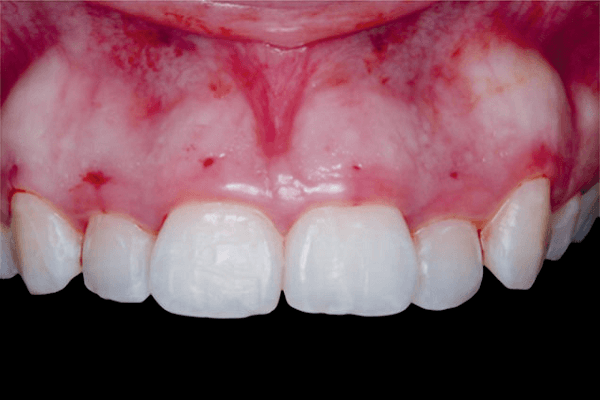RESUMO
Uma das queixas estéticas de pacientes que buscam harmonia do sorriso é a exposição gengival excessiva, chamada “sorriso gengival”. Existem diferentes etiologias e formas de tratamento do sorriso gengival, sendo algumas situações clínicas resolvidas com abordagem periodontal através do aumento de coroa clínica estética. No entanto, alguns detalhes técnicos são essenciais no planejamento e execução deste procedimento cirúrgico. Sendo assim, o presente trabalho teve como objetivo relatar um caso clínico, evidenciando as etapas cirúrgicas realizadas para obtenção de um resultado harmônico e estético. A queixa principal da paciente era seu sorriso gengival excessivo. Ao exame clínico, foi observada linha de sorriso alta e erupção passiva alterada (EPA), e coroas clínicas curtas. A paciente apresentava biotipo periodontal espesso, com ampla faixa de mucosa ceratinizada. Ela foi classificada como EPA tipo I associada à erupção ativa alterada (EAA), já que apresentava crista óssea coincidente com a junção cemento/esmalte (JCE). Foi planejado o aumento de coroa clínica estética dos dentes 14 ao 24 com incisão em bisel interno (45o em relação ao longo eixo do dente), para remover altura e espessura de tecido gengival. A incisão na região interproximal envolveu as papilas, já que estas se apresentavam volumosas. Foi feito retalho total para possibilitar a osteotomia e osteoplastia, devolvendo melhor contorno ósseo e espaço adequado entre a crista óssea e JCE (aproximadamente 2 mm). A paciente mostrou-se muito satisfeita no pós-operatório, havendo estabilidade dos resultados alcançados graças ao diagnóstico, planejamento e tratamento adequados.
Palavras-chave – Periodontia; Odontologia cosmética; Protocolos clínicos; Retalhos cirúrgicos.
ABSTRACT
One of the aesthetic complaints of patients seeking harmony of the smile is the excessive gingival exposure, called “gummy smile”. There are different etiologies and ways of treatment of the gingival smile, and some clinical situations are solved with periodontal approach through aesthetic crown lengthening. However, some technical details are essential in the planning and execution of this surgical procedure. Thus, the present study aims to report a clinical case, evidencing the surgical steps performed to obtain a harmonic and aesthetic result. The patient’s main complaint was her excessive gummy smile. Clinical examination revealed a high smile line and altered passive eruption (APE) and short clinical crowns. The patient had a thick periodontal biotype with a wide range of keratinized mucosa. It was classified as EPA-type I associated with altered active eruption (AAE), since it had a crestal bone coincident with the cement-enamel junction (CEJ). The aesthetic clinical crown lengthening from teeth 14 to 24 was planned with an internal bevel incision (45o to the long axis of the tooth) to remove height and thickness of gingival tissue. The incision in the interproximal region involved the papillae, since they were bulky. A full-thickness flap was made to allow osteotomy and osteoplasty, giving a better bone contour and adequate space between the bone crest and CEJ (approximately 2 mm). The patient was very satisfied in the postoperative period, with stability of the results achieved, due to adequate diagnosis, planning and treatment.
Key words – Periodontics; Cosmetic dentistry; Treatment protocol; Surgical flaps.
Referências
- Peck S, Peck L, Kataja M. The gingival smile line. Angle Orthod 1992;62(2):91-100.
- Borghetti A, Monnet-Corti V. Cirurgia plástica periodontal (2ª ed.). São Paulo: 2011. p.50-86.
- Malkinson S, Waldrop TC, Gunsolley JC, Lanning SK, Sabatini R. The effect of esthetic crown lengthening on perceptions of a patient’s attractiveness, friendliness, trustworthiness, intelligence, and self-confidence. J Periodontol 2013;84(8):1126-33.
- Dutra MB, Ritter DE, Borgatto A, Derech CDA, Rocha R. Influência da exposição gengival na estética do sorriso. Dental Press J Orthod 2011;16(5):111-8.
- Allen EP. Surgical crown lengthening for function and esthetics. Dent Clin North Am 1993;37(2):163-79.
- Mele M, Felice P, Sharma P, Mazzotti C, Bellone P, Zucchelli G. Esthetic treatment of altered passive eruption. Periodontology 2000 2018;77(1):65-83.
- Zangrando MSR, Veronesi GF, Cardoso MV, Michel RC, Damante CA, Sant’Ana ACP et al. Altered active and passive eruption: a modified classification. Clinical Advances in Periodontics 2017;7(1):51-6.
- Nart J, Carrió N, Valles C, Solís-Moreno C, Nart M, Reñé R, Esquinas C, Puigdollersi A. Prevalence of altered passive eruption in orthodontically treated and untreated patients. J Periodontol 2014;85(11):e348-53.
- Joly JC, de Carvalho PFM, da Silva RC. Reconstrução tecidual estética: procedimentos plásticos e regenerativos periodontais e peri-implantares (1a). Porto Alegre: Artes Médicas, 2009.
- Rossi R, Brunelli G, Piras V, Pilloni A. Altered passive eruption and familial trait: a preliminary investigation. Int J Dent 2014;2014:874092.
- American Academy of Periodontology (4a). Glossary of periodontal terms. American Academy of Periodontology, 2001.
- Gargiulo AW, Wentz FM, Orban B. Dimension and relations of the dentogingival junction in humans. J Periodontol 1961;32(3):261-7.
- Alpiste-Illueca F. Altered passive eruption (APE): a little -known clinical situation. Med Oral Patol Oral Cir Bucal 2011;16(1):e100-4.
- Amsterdam MA. Form and function of the masticatory system. Philadelphia: University of Pennsylvania, 1991.
- Coslet JG, Vanarsdall R, Weisgold A. Diagnosis and classification of delayed passive eruption of the dentogingival junction in the adult. Alpha Omegan 1977;70(3):24-8.
- Cairo F, Graziani F, Franchi L, Defraia E, Pini Prato GP. Periodontal plastic surgery to improve aesthetics in patients with altered passive eruption/gummy smile: a case series study. Int J Dent 2012;2012:837658.
- Ribeiro FV, Hirata DY, Reis AF, Santos VR, Miranda TS, Faveri M et al. Open-flap versus flapless esthetic crown lengthening: 12-month clinical outcomes of a randomized controlled clinical trial. J Periodontol 2014;85(4):536-44.
- Cayana EG, Greggianin BF, Angst PD, Gomes SC, Oppermann RV. Measuring periodontal biologic distances: transperiodontal vs transsurgical probing. Acta Odontol Scand 2013;71(6):1632-5.
- Zanatta FB, Giacomelli BR, Dotto PP, Fontanella VR, Rosing CK. Comparison of different methods involved in the planning of clinical crown lengthening surgery. Braz Oral Res 2010;24(4):443-8.
- Januario AL, Barriviera M, Duarte WR. Soft tissue cone-beam computed tomography: a novel method for the measurement of gingival tissue and the dimensions of the dentogingival unit.
J Esthet Restor Dent 2008;20(6):366-73. - Silva CO, Soumaille JMS, Marson FC, Progiante PS, Tatakis DN. Aesthetic crown lengthening: periodontal and patient-centred outcomes. J Clin Periodontol 2015;42(12):1126-34.



